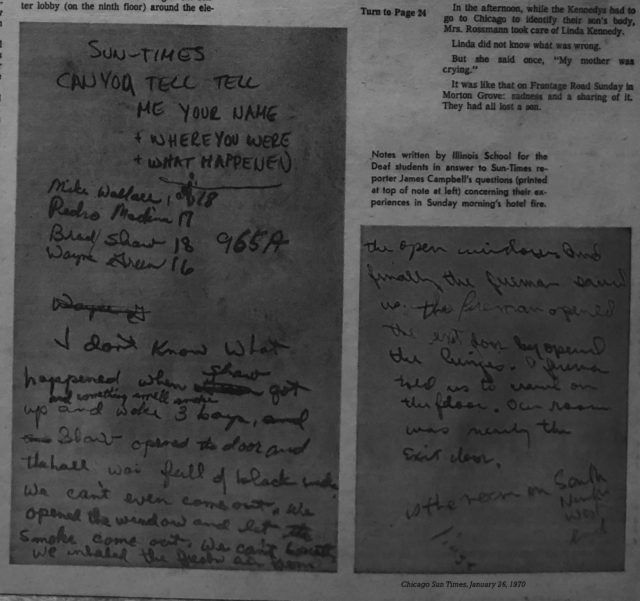Originally appeared in Silent News, May 2001.
This month’s issue is of particular interest to me. There are many stories that relate to lawsuits, and three stories that relate to protests or rallies (Maryland, Connecticut and California). I’m not sure why there are so many stories this month on these topics…perhaps because of our new president and the party change to Republican. Or perhaps it’s because it’s that time of the year – legislation being passed and signed into law and school years coming to an end with faculty/staff preparing for next year. Whatever the reasons – it makes me wonder if we’ve truly made progress in our lives. With the passage of the Americans with Disabilities Act, we all had hope that our lives would finally become convenient with closed captioning, TTYs, and simple accessibility.
To explore this further, I went back into our storage room where we keep all the old issues dating back to 1969. I sat down and found countless issues even back in the 1970s with front-page stories that proclaimed problems with communication accessibility. It’s been 30 years, and we still are struggling. We are probably more aware of our rights today, which may explain the influx of lawsuits and public protests, but we’ve still got a long way to go.
Another story this month that really hit home for me was the James Levier shooting. As I read the official report that ruled the shooting by Maine police as justifiable, I was suddenly reminded of the Eric Smith shooting in Illinois. Eric was someone I grew up with at summer camp, and then a fellow student at Gallaudet. He was beaten by Washington, DC police in a case of mistaken identity, and severly traumatized by that experience. He left school to go back to Joliet, Ill., to try and recuperate from that experience. Eric was attending therapy and drug counseling when he got into an argument with his mother along I-55. They pulled over and to make a long story short, two police cars, both with volunteer policemen, pulled up and eventually shot Eric six times, finally killing him with the sixth shot.
The night I heard about the shooting on the local news, I e-mailed my notetaker from stats class and told him that he and the cops had screwed up (though I used far more colorful words).
You see, my notetaker at that time — purely by coincidence — was Captain Kenneth Bouche, who is a top administrator with the Illinois State Police. Ken, who was in charge of the investigation into Eric’s shooting, told me to wait until I knew the whole story before I pointed the finger at the police. We discussed the shooting at length later on. After I learned the details of the case, I realized that indeed, the shooting was justifiable – even as much as it pains me to say that.
Eric (6’1”, 260 pounds and a former state wrestling champion) held one of the policemen — who was 5’3” — up in the air with one hand around the uniformed policeman’s neck, shaking him “like a rag doll,” as a witness said. There were 20 witnesses, and 19 had the same account of what happened. Eric should also have immediately ceased when he saw the uniformed police (regardless of his past trauma with the D.C. police). Still, I wonder if the police had misunderstood Eric’s gestures (they claim he was hitting his mother in the car. I wonder if he had simply been tapping her on the shoulder).
Within a month, another shooting took place in Illinois — this time, downstate — where a deaf man was killed. Again, a miscommunication was the cause. The police claimed Stephen Helmig — a man who couldn’t speak — had voiced repeatedly, “I’m going to kill you” as they encountered each other in the dark during a reported break-in.
With the two shootings, Captain Bouche, a wonderfully aware and keen man, determined that the unifying problem in all these shootings, in addition to having heard some of my own personal experiences with police, was miscommunication. As he said once, police can be idiots when it comes to understanding communication with deaf people. Another point he made that I found especially valid was that in all of his years as a policeman, he’d only met one deaf person. Meanwhile, every deaf person out in the community has met many, many police officers.
Bouche then formed a committee or a task force of sorts, and after two years of research and studies, that committee began teaching courses on communication issues (mind you, not teaching sign language, but rather, teaching about resources available and how to communicate with various types of deaf people, hard of hearing people, and others) at the Illinois Police Academy in Springfield. A “picture book” was also created by Sergeant John Garner of Springfield, and is in nearly every state police vehicle. These are only temporary patches and by no means anywhere near the importance of having full communication access. Even so, it does distress me to see this continuing over and over in so many states. Errol Shaw, James Levier, Eric Smith, Stephen Helmig.
Whenever I visit my parents in Illinois, I often have to drive on I-55. I know exactly the spot where Eric was shot and killed: 1/4 mile north of Harlem Avenue. And when I drive by, I think about all the times we get pulled over by police (my infamous speeding!) and how many times I get worried that communication will get mangled because of ignorance both on the police’s part and the deaf person’s part.
So, as I read the story about Levier, I felt a sense of horror and worry. First, that Levier was so despondent he felt he had to go to such extreme measures. Second, that the police felt the need to keep shooting at him — not twice, not thrice, but seven times. Third, that this won’t be the last time someone gets killed because of being deaf, or ignorance.
The next time we get pulled over for speeding or call the police for an incident in our homes, we’d better hope that the next bullet isn’t for us.
Copyrighted material. This article can not be copied, reproduced, or redistributed without the written consent of the author.




